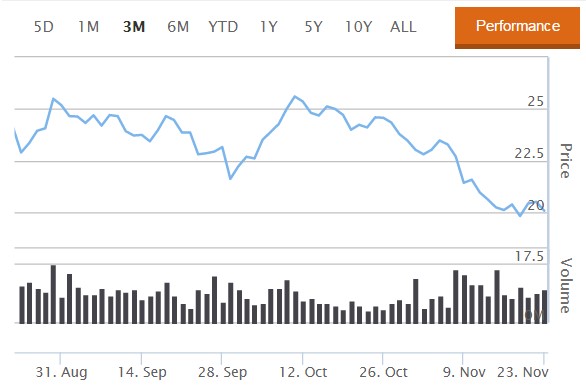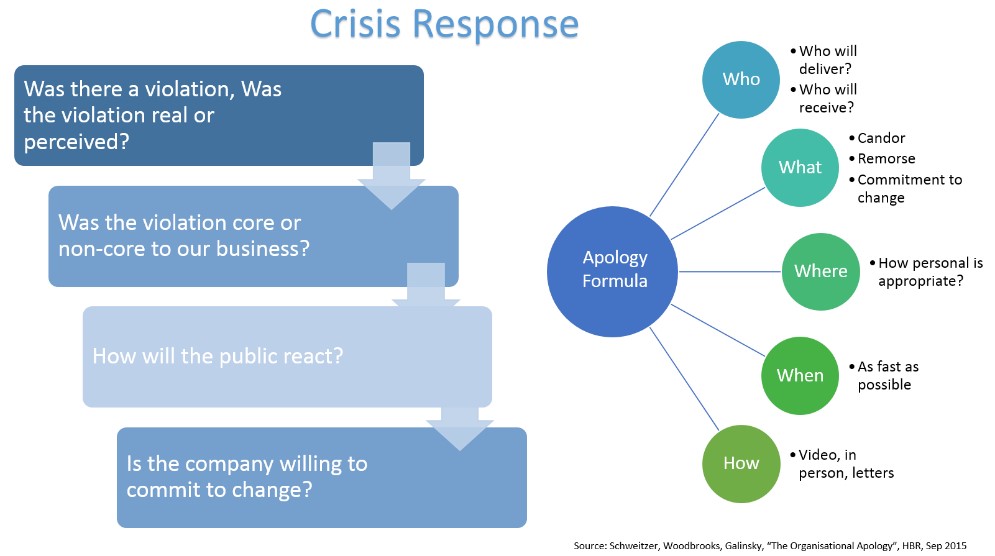We’ve all recently been shocked by the BHP Samarco disaster which saw 11 Brazillian villagers lose their lives, with 15 still reported as missing. This tragedy has rocked BHP, with Samarco’s publically traded bonds initially losing 50% of their value.
So, what can the Food and Beverage industry take away from this crisis?
People are always going to want answers to disasters, and in corporate culture, responsibility ultimately stems from the top.
Whilst CEO Andrew Mackenzie may not be directly responsible for the BHP crisis, as their top representative the onus is on him to own up to their mistakes. This is no different from the Food and Beverage industry. In a crisis it’s you, as the C-level Executive, who will be held accountable.
In this month’s blog we’ll use BHP’s crisis to evaluate their reaction and what the Food and Beverage industry can learn about crisis management.

Graph of BHP’s share price dropping to six year lows after the Samarco incident
What can we learn from BHP?
Obviously, $300 million in fines and BHP’s share price dropping to six year lows is a problem, but if their reputation fails to recover their ability to recoup these losses will diminish.
Take a moment to review the apology Andrew issued after the crisis.
Apologies go a long way to repairing reputational damage, and this apology ticks all the correct boxes which have to be ticked to begin mitigating the impact of long term reputation damage.
Andrew was candid, he showed genuine remorse, and a commitment to change. Coupled with the apology being issued on site and in such a timely manner means BHP is undoubtedly thinking long term about their reputation’s position.
Now, whether this is enough to save Andrew from a board baying for blood is another story, but at this stage BHP is doing everything they can to mitigate the impact of this crisis on their share price.
Lessons you can learn
BHP had the right idea with their apology. Compare their apology to Pattie’s Foods who continues to argue the point about whether or not they were at fault and has yet to issue an apology for allegations of spreading hepatitis A to consumers. The reality is for Patties, the horse has bolted! They have lost consumer confidence and therefore market share. Whether they were at fault or not is largely irrelevant.
During a crisis we’re often afraid to apologies in case it amounts to an admission of guilt. But, in the case of Patties, when you’re making statements around changing your Chinese supplier in reaction to the allegations, you may as well apologise and improve your brand positioning.
How to apologise during a crisis
The Harvard Business Review provides a framework for structuring an apology during a crisis[1]:
1. Who
The more serious the crisis the more senior the apology. However, it’s not always this simple. The apology has to be directed at ALL groups impacted. If the group is too large and diffuse, then an open apology through the press or social media may be more acceptable.
2. What
These are the words you’ll say and the actions you’ll take. An excellent framework for this is to show candor, remorse, and a commitment to change and if you’re thinking long term then owning the situation is absolutely critical.
3. Where
Establish the setting of the apology. Balance the ability to be at the scene with the need to respond quickly (refer below). However, public apologies can be extremely risky as you’re placing a leader in an uncontrolled environment. In these situations the leadership must be adequately prepared or else they could do more bad than good.
4. When
Apologise quickly. Speed is a sign of sincerity and it shows you’re committed to acting on the crisis.
5. How
The way you deliver an apology can matter just as much as the content of the apology. Written statements have the benefit of being broadcast quickly, but you’ll risk not conveying the right tone, like you would with speech. Tools such as YouTube can be very effective to personalise messages and distribute widely.
How can I protect my organisation for an unforeseen crisis?
A crisis can seriously impact your organisation, and the impact of poorly managing it can be even worse in the long run.
Patties Foods are still feeling the impact of their crisis. According to Managing Director Stephen Chaur, their past consumers have transitioned a majority of their purchases towards fresh berries, completely abandoning what was once the market leader in frozen berries.
If you’re a board member of an organisation have you recently reviewed your crisis management plan? Or are you just planning on ‘dealing with it’ when something comes up?
As a bare minimum your organisation should have a series of plans which include pre-determined templates and communications that can be distributed to the media. Alternatively, appropriate third party support to assist in this scenario.
Again, speed is everything when it comes to mitigating the reputational damage from a disaster. These plans should be focused on the key stakeholders within your business, both internal and external. They should detail who and how these messages will be delivered. .
Similarly, as a C-level executive you may want to consider media training should a crisis occur.
Finally, if you’re concerned your organisation isn’t prepared enough to manage during a crisis feel free to contact the Victual team for a comprehensive review of your crisis management plan.
[1] Schweitzer, Woodbrooks, Galinsky, “The Organisational Apology”, HBR, Sep 2015



